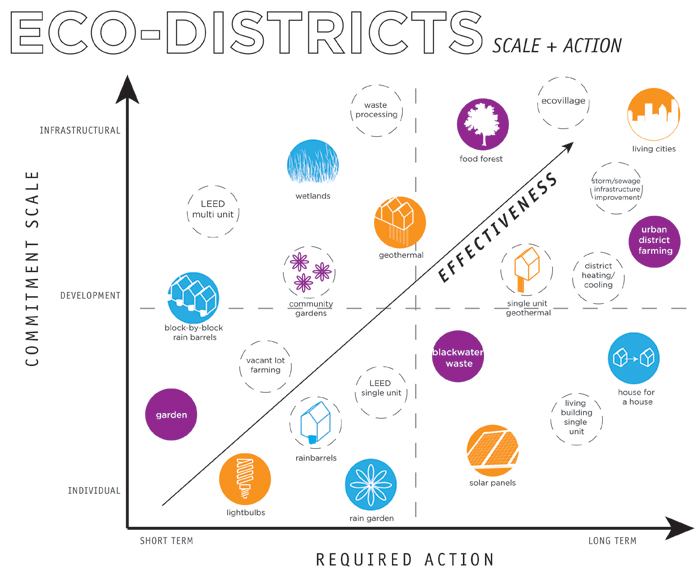The Scaling of Sustainable Development: Eco-districts
When it comes to making a difference, we’ve all been in a place that gets us feeling like what we are doing isn’t making that big of an impact. Research has shown that when the going gets tough, people change their attitudes, not their behaviors. That is to say: when the barriers to change are seen as too difficult to over come, people are more likely to stop caring as opposed to ramping up their efforts to brake down those obstacles. Yes, this is a bleak realization, but there is hope!
While the research tells us that people do give up on things they care about, it also shows that when people band together around a topic there is little they are not willing to collaboratively tackle. The group mentality—which is so often demonized for its ability to deplete our individuality—can actually be helpful when it comes to driving progress. This new view of the group mentality helps illustrate why conferences can be imperative when pressing forward with a cause.
I went to an Eco-district Summit in Portland recently and came back with the realization that people all over the world are facing the same difficulties we are here in Pittsburgh. There isn’t a successful eco-district out there that didn’t come up against some serious barriers on its way to fruition. The benefit of gatherings like this summit are immeasurable; people from all over the world are able to come together and hash out what works as well as lessons learned.

evolveEA created the above chart to help community planners gauge the effectiveness of sustainability measures by plotting their scale, from the individual to infrastructural level, in relation to required time commitment.
An inherent theme at any eco-districts gathering is scale. Scale is a prerequisite consideration before attempting to tackle any sustainability problem and can really make or break a project. Innovations of every imaginable size were discussed and their reproducibility was measured based on the difficulties faced. The most glaring example is that of the congestion tax in London. Mark Watts of Arup Corporation discussed how a strong leader could take public opinion with them in the advancement of revolutionary policy if public perception is taken into account when presenting something controversial. Mark said that when London’s mayor rolled out the groundbreaking program, he phrased the changes in a way that took the emphasis off of the polarizing topic of climate change and environmental protection and focused on the convenience that would come with increased public transportation options and decreased traffic. When the program became a success, Mayor Ken Livingstone asked a group of mayors from around the world if they would do it themselves. Only one outspoken mayor from a southern U.S. city responded, “If it works and you get re-elected, then I’ll consider it.”
While our own eco-districts work in Larimer has yet to be fully instituted, we at evolveEA have a firm understanding of the likely issues on the way to a sustainable eco-district. That understanding coupled with the help of like-minded organizations like the Kingsley Association has brought evolveEA to the cutting edge in eco district design. Our award from the Pittsburgh AIA for our work in Larimer is a testament to our thought leadership in this area and our ability to bring truly sustainable living to the community scale. Because, as the saying goes, attempting to address urban sustainability one building at a time is like trying to address deforestation one tree at a time.

